Now Approaching the Emerald City
Greening the city doesn’t appear to be waning anytime soon. San Francisco is continuing to transform parking spaces into parks and provide tax incentives for urban agriculture. Chicago is planning to sell city-owned abandoned lots to residents for $1 in the hope that committed citizens will transform blights into gardens. Projects like The High Line, in New York City, and Gas Works Park, in Seattle, have shown how existing city infrastructure can serve as the perfect foundation for a park.
On a smaller scale, designers and architects are bringing ideas and projects normally reserved for professionals like them to the people. “We want to help users be the designer,” says architect and product designer Mario Gentile. These designers are focusing on simplicity and accessibility, requiring only an interest in adding plants to the city and a do-it-yourself attitude on the part of users. The goal is to make it easy to add green to spaces in an artistic and personalized way, regardless of location, design experience or financial means.
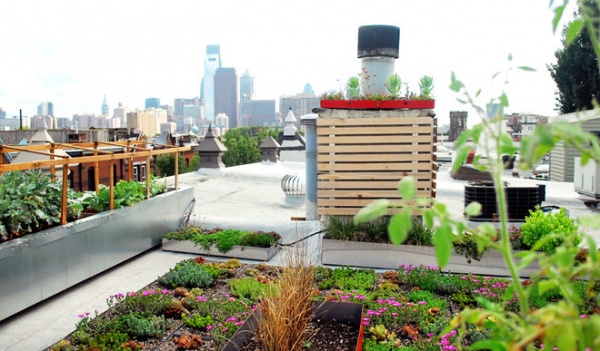
Green roofs have become a symbol of planting the city; many companies now specialize in their design, installation and maintenance. A study conducted by the National Research Council of Canada concluded that while conventional roofs can be up to 90 degrees Fahrenheit hotter than the surrounding air, green roofs can actually be cooler. In addition, green roofs can reduce a building’s energy costs by better insulating against heat and cold, help manage stormwater and reduce air pollution. But often these are commercial-grade systems that come at a high price and require extensive structural retrofitting. They aren’t something you can pick up at the home improvement store and aren’t necessarily designed with the homeowner in mind.
These were architect Mario Gentile’s concerns when he decided to enter the green roof market five years ago. When he founded Shift_Design, a Philadelphia design company that specializes in sustainable and attractive outdoor products, “we were trying to improve on the blue barrel,” Gentile says, referring to the standard-issue rain barrel. More product upgrades followed, including stormwater management devices, living walls and now green roofs.
Shown: Private garden in Philadelphia planted in 2012 with Shift_Design’s Fairmount Living tiles
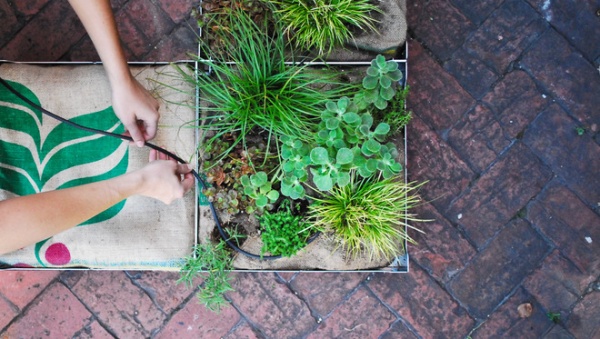
Fairmount Tiles - $150Gentile wanted to put the power of urban garden design in the hands of the people who would be using these products, and decided to take a DIY approach to green roof design. By creating a product that was easy to make, ship and use, he could transform flatter, more impervious surfaces into gardens more quickly and efficiently.
It took four years for Gentile and his team to develop their living roof design, with the Fairmount Living Tile, which launched early this month. “We’ve gone through many iterations,” says Gentile. A lightweight recycled and recyclable aluminum frame forms the tile. The kit includes a lightweight custom soil blend made from composted Christmas trees and pumpkins picked up by garbage collectors in New York City. Because the soil is so lightweight, salvaged coffee bags from La Colombe, a local Philadelphia roaster, cover the soil and prevent it from blowing away. Lines for drip-line irrigation also come with the kit for watering the sedum or other plants that can grow in the 4-inch trays.
The result is an incredibly light modular green roof tile. “Most green roofs weigh double what ours weigh when saturated,” says Gentile. “You can put this on a roof that is not designed to be a green roof.” When multiple tiles are connected, their combined weight keeps them secure on the roof, says Gentile.
These tiles were designed for the urban environment, but that doesn’t mean they are exclusive to roofs or cityscapes. “They can be used wherever,” says Gentile, including concrete patios, flat roofs and decks. Their modular design makes it easy for users to modify the tiles for their own spaces.
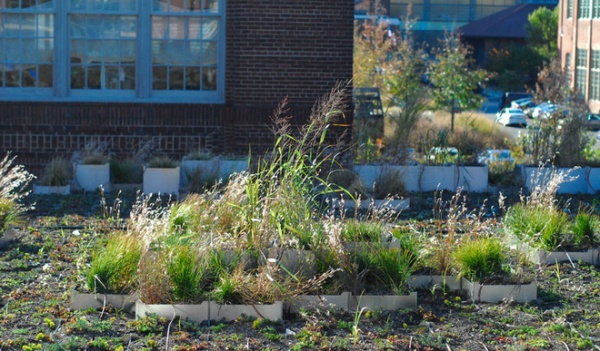
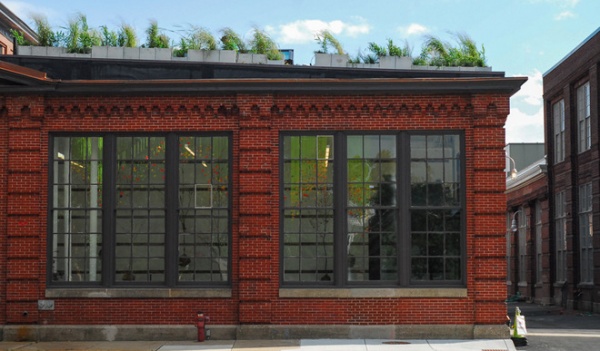
Gentile installed a green roof using Fairmount tile on Urban Outfitters’ headquarters in Philadelphia, shown here. A variety of planter depths, from 4 to 16 inches, was used to create an undulating tapestry of sedum, grasses and rooftop-tolerant plants — distinguished both in plan and in section for sidewalk passersby.
Though only the 4-inch planters are available now, Gentile hopes to launch 8- and 16-inch-depth tiles soon. All tiles will fit together and allow users to personalize their own urban landscapes.
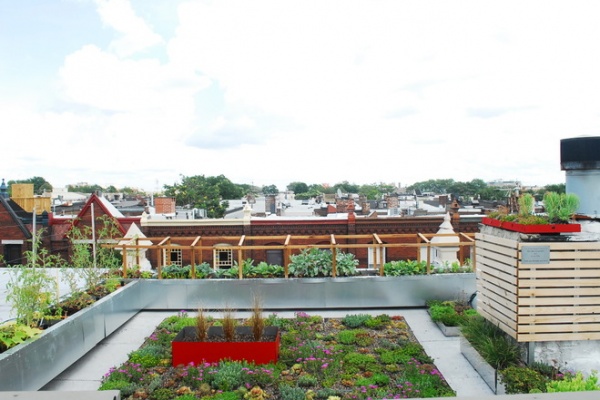
Gentile designed the green roofs to be ready to use once they arrive, with everything but the plants included. All the products arrive flat packed. “We’re paying attention to the details,” he says, providing customers with an attractive roof tile that is sustainably made in the USA. Baker Industries, a nonprofit rehabilitation program for at-risk adults, assembles and delivers the kits.
Gentile says Shift_Design has been talking to members of community gardens interested in using Fairmount tiles on brownfield sites instead of raised beds. Schools and newer upstart programs are interested too.
Learn more about the Fairmount Living Tile by Shift_Design
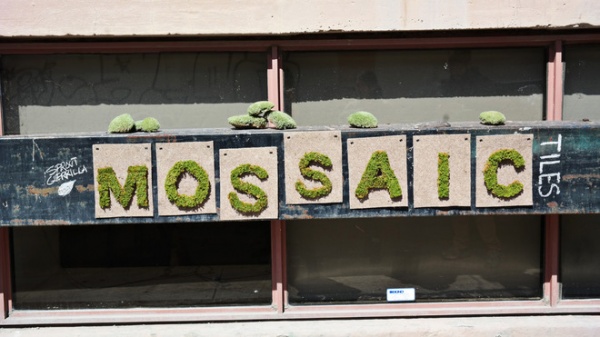
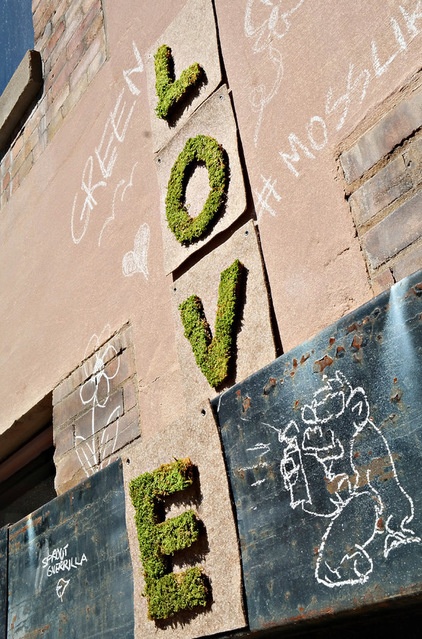
Those who live in cool, shady, damp climates will be familiar with moss, which grows easily on porous surfaces like brick and concrete. Though some see it as a nuisance; others see it as an untapped opportunity. “It’s a great add-on to our existing infrastructure,” says Julie Forand, founder of Sprout Guerrilla.
Moss requires water to get started and does best in moist, shady conditions. Once established it’s relatively maintenance free. During times of stress or drought, moss goes dormant, but revives itself once it receives water again. According to Moss Acres, a specialty moss nursery, “breezes that flow across greenery gently clean the air of particulates, as they are trapped by the moss plants and then retained in the soil mixture.” Unlike urban trees, moss requires very little space or infrastructure to establish itself.
Forand was finishing her degree at the Ontario College of Art and Design University when she directed her attention, and a part of her thesis project, toward moss. She had been aware of moss paint and moss graffiti for a while, and saw this as a great way to bring nature and cities together. She created a moss graffiti kit to bring moss to the masses in an accessible and artistic way.
The kit includes enough hypnum moss for 1 square foot of coverage and instructions for making the moss smoothie used as “paint.” After the moss art is painted, it can take six to eight months to reach optimal fluffiness and will last indefinitely. Hypnum moss does well with little sunlight and thrives in urban conditions that would impede other plants. Forand says her team at Sprout Guerrilla confirms that the moss they use is suitable to a region before fulfilling each online order.
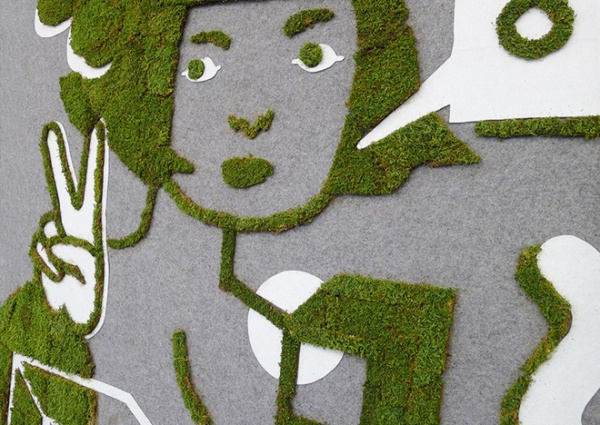
During The Artist Project 2014, a contemporary art fair in Toronto, Forand and artist Jennifer Illet collaborated on two 60-inch by 72-inch murals, titled “Hello/Goodbye” (“Hello” is shown here), using moss and felt with white accents. This departure from the typical living wall shows how limitless this medium is for transforming barren walls and urban surfaces. “We use moss as an artistic medium,” says Forand.
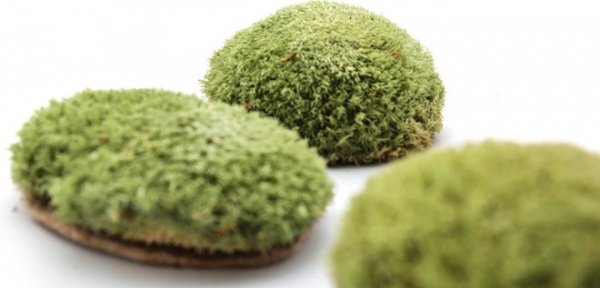
For desktops and tabletops, Sprout Guerrilla designs button-shaped moss cushions. Forand hopes these simple efforts will create a big impact. “It’s a fun way to enable people to use other materials,” she says.
Learn more about Sprout Guerrilla
More: 6 Green-Roof Myths, Busted












